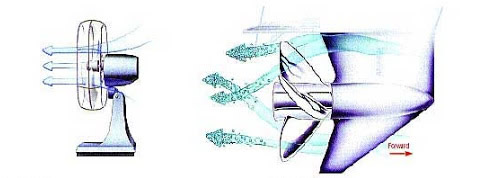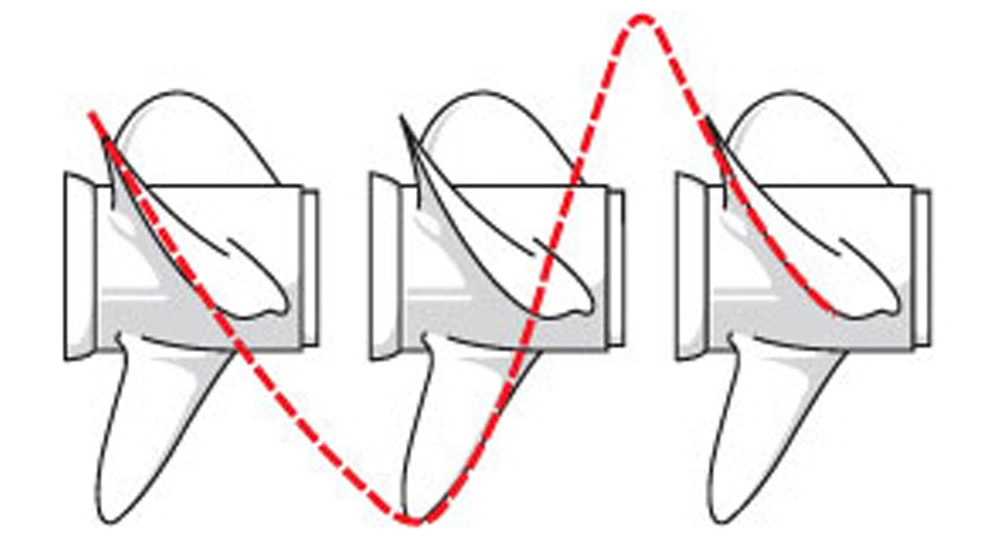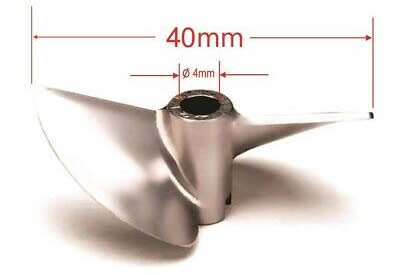
Choosing the Right Propeller for Your Boat
Arguably the most important part of any boat engine is the propeller. Whether you have 4 hp or 400 hp, a boat engine without a propeller is nothing more than a noisy anchor consuming gasoline.
To understand exactly what type of propeller is recommended for your boat, we must first understand exactly how it works, what the difference is between 2, 3, and 4 blades, and what the relationship is between pitch and diameter.
How it works

As you can see in the picture above, it is a clockwise propeller with blades moving from top to bottom, left to right. As the blade (paddle) moves down, it pushes the water down and back (just like swimming). At the same time, the water must move quickly behind the blade to occupy the free space. This creates a pressure difference between the two parts of the blade. Behind the blade, we have positive pressure pushing, and in front of the blade, we have negative pressure pulling water.
These reactions take place on all the blades of the propeller at each of its revolutions. So the propeller, the engine, and everything associated with it are both pulled and pushed on the water.
This pressure difference pulls the water into the propeller and throws it behind; the principle of operation is identical to that of a fan that sucks air from behind and "throws" it forward.
The more blades it has, the more "water" it moves, which means more thrust is created.
Pitch

Propeller pitch can be defined as the distance the propeller travels in a single 360° rotation. For example, a propeller with a pitch of 20 "moves 20" per complete revolution.
A smaller step increases the acceleration and "pushing" power of the engine, and a larger step increases the speed of the boat as long as the engine develops enough power to maintain an optimum number of revolutions per minute.
It is very important to choose the pitch based on how you are using the boat. A heavy boat needs the engine to develop more thrust and therefore requires a propeller with a smaller pitch. A smaller pitch increases the acceleration power and helps the engine to reach a maximum RPM at lower speeds; unfortunately, this means departing from the maximum speed.
A larger step helps the boat reach a higher speed but decreases traction. A heavy boat with too large a step will not develop enough power to plane and can cause severe engine damage.
To find out the optimum pitch for your boat, you need to do a simple test. The idea is to rev the engine to maximum (with the boat loaded as at normal speed), noting where you are about the maximum RPM limit given in the owner's manual. Note that increasing the pitch by one inch decreases RPM at full acceleration by 150 to 200 RPM, and decreasing the pitch by one inch increases RPM by 150 to 200 RPM.
For example, an engine equipped with a pitch of 21 develops 4200 RPM, but the upper limit of RPM of the engine is 4600 RPM. To reach the maximum potential of the engine, you need a propeller with a pitch of 19. If the engine is running at maximum, the tachometer shows 6100 RPM, and the limit is 5600; clearly, the pitch must be increased.
If you want to change from a 3-blade to a 4-blade propeller (for more traction), you have to keep in mind that the 4th blade usually develops 50-100 RPM less than a 3-blade propeller at the same pitch.
This test is the safest and easiest way to find out exactly which step is ideal for your engine and boat.
Diameter

The propeller diameter is the diameter of the imaginary circle formed by the complete revolution of the propeller (from the blade tip). The diameter is determined by the number of RPM and the power transmitted to the propeller. Practically, the diameter increases with the propellers with a smaller pitch (for heavier boats) and decreases with the propellers with a larger pitch.
In simpler terms, when the diameter is larger, the propeller pushes more water and requires more engine power, and vice versa.



